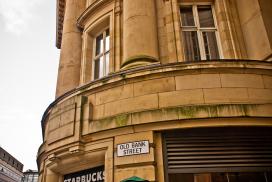In Greater Manchester
- How money from slavery made Greater Manchester
- The importance of cotton in north west England
- The Lancashire cotton famine
- Smoking, drinking and the British sweet tooth
- Black presence in Britain and north west England
- Resistance and campaigns for abolition
- The bicentenary of British abolition
Global

Old Bank Street, Manchester
How did money from slavery help develop Greater Manchester?
The port cities of Liverpool, London and Bristol are most often linked with the transatlantic slave trade. However, direct and indirect profits from slavery fuelled the Industrial Revolution in Greater Manchester.
Cotton was the most important commodity in the north west of England, particularly in developing the towns of Bolton, Oldham, Manchester and Rochdale. Much of the local profits came after the British abolished the slave trade in 1807 and finally abolished slavery in 1838. Cotton was supplied through the system of American slavery until 1865. As the Caribbean historian Eric Williams points out: ‘It was this tremendous dependence on the triangular trade that made Manchester'.
The wealth created primarily by cotton led to a boom in related industries including banking and industrial engineering to service the textile mills. The rapid growth of the textile industries in the north west of England changed the landscape as mills and warehouses were built across the region. It was said that:
‘There was not a village within 30 miles of Manchester on the Cheshire and Derbyshire side in which the manufacture of cotton was not carried on’.
The wealth generated through the transatlantic slave trade is reflected in the grand buildings of Manchester, especially in and around Mosley Street, Piccadilly and Portland Street as well as the many vast warehouses.
New transport links were also developed to allow the easy movement of raw cotton and processed goods within the region and to the port of Liverpool. The Bridgewater and Rochdale Canals and the Liverpool and Manchester Railway were most significant.
Some of the wealth from the region’s links to slavery has benefited the public as philanthropists, such as the Greg and the Lees families, donated money and artworks to local cultural institutions such as Manchester Art Gallery, Gallery Oldham and the Whitworth Art Gallery.